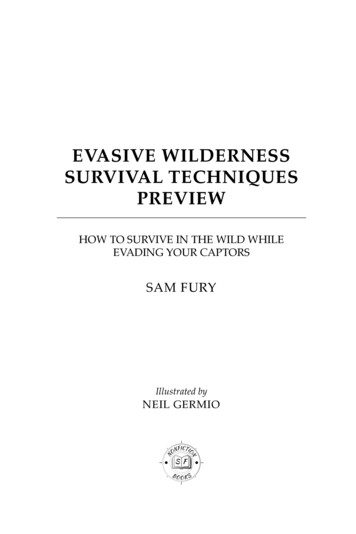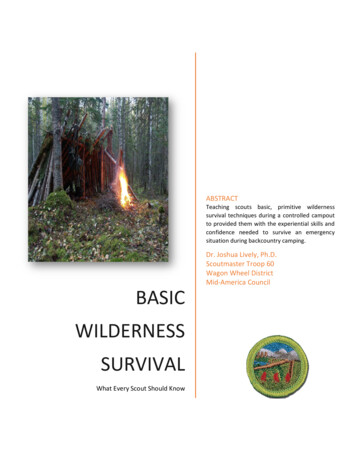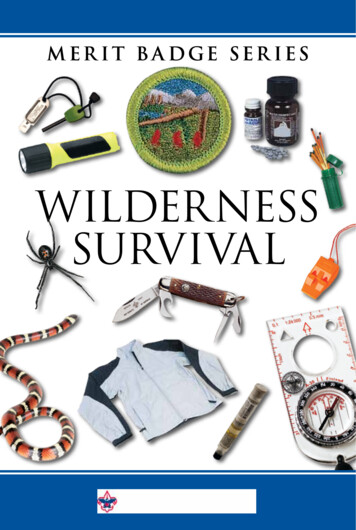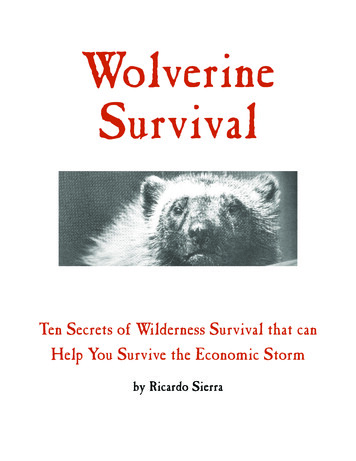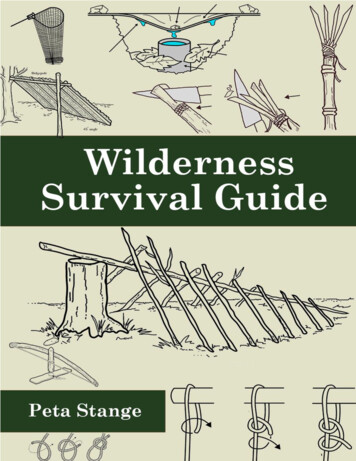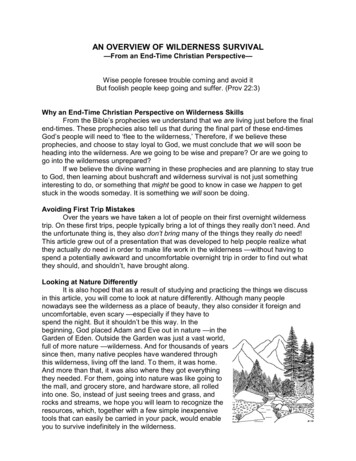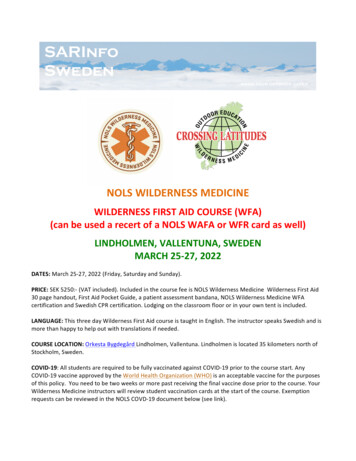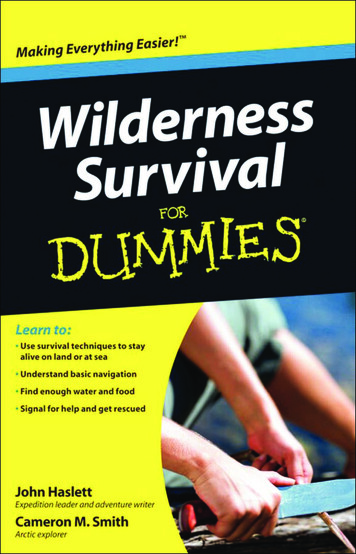
Transcription
Wilderness SurvivalFORDUMmIES‰by John Haslett andCameron M. Smith, PhD
Wilderness Survival For Dummies Published byWiley Publishing, Inc.111 River St.Hoboken, NJ 07030-5774www.wiley.comCopyright 2009 by Wiley Publishing, Inc., Indianapolis, IndianaPublished by Wiley Publishing, Inc., Indianapolis, IndianaPublished simultaneously in CanadaNo part of this publication may be reproduced, stored in a retrieval system or transmitted in anyform or by any means, electronic, mechanical, photocopying, recording, scanning or otherwise,except as permitted under Sections 107 or 108 of the 1976 United States Copyright Act, withouteither the prior written permission of the Publisher, or authorization through payment of the appropriate per-copy fee to the Copyright Clearance Center, 222 Rosewood Drive, Danvers, MA 01923,(978) 750-8400, fax (978) 646-8600. Requests to the Publisher for permission should be addressed tothe Permissions Department, John Wiley & Sons, Inc., 111 River Street, Hoboken, NJ 07030, (201) 7486011, fax (201) 748-6008, or online at http://www.wiley.com/go/permissions.Trademarks: Wiley, the Wiley Publishing logo, For Dummies, the Dummies Man logo, A Referencefor the Rest of Us!, The Dummies Way, Dummies Daily, The Fun and Easy Way, Dummies.com,Making Everything Easier, and related trade dress are trademarks or registered trademarks of JohnWiley & Sons, Inc. and/or its affiliates in the United States and other countries, and may not be usedwithout written permission. All other trademarks are the property of their respective owners. WileyPublishing, Inc., is not associated with any product or vendor mentioned in this book.LIMIT OF LIABILITY/DISCLAIMER OF WARRANTY: THE PUBLISHER AND THE AUTHOR MAKENO REPRESENTATIONS OR WARRANTIES WITH RESPECT TO THE ACCURACY OR COMPLETENESS OF THE CONTENTS OF THIS WORK AND SPECIFICALLY DISCLAIM ALL WARRANTIES,INCLUDING WITHOUT LIMITATION WARRANTIES OF FITNESS FOR A PARTICULAR PURPOSE.NO WARRANTY MAY BE CREATED OR EXTENDED BY SALES OR PROMOTIONAL MATERIALS.THE ADVICE AND STRATEGIES CONTAINED HEREIN MAY NOT BE SUITABLE FOR EVERY SITUATION. THIS WORK IS SOLD WITH THE UNDERSTANDING THAT THE PUBLISHER IS NOTENGAGED IN RENDERING LEGAL, ACCOUNTING, OR OTHER PROFESSIONAL SERVICES. IF PROFESSIONAL ASSISTANCE IS REQUIRED, THE SERVICES OF A COMPETENT PROFESSIONALPERSON SHOULD BE SOUGHT. NEITHER THE PUBLISHER NOR THE AUTHOR SHALL BE LIABLEFOR DAMAGES ARISING HEREFROM. THE FACT THAT AN ORGANIZATION OR WEBSITE ISREFERRED TO IN THIS WORK AS A CITATION AND/OR A POTENTIAL SOURCE OF FURTHERINFORMATION DOES NOT MEAN THAT THE AUTHOR OR THE PUBLISHER ENDORSES THEINFORMATION THE ORGANIZATION OR WEBSITE MAY PROVIDE OR RECOMMENDATIONS ITMAY MAKE. FURTHER, READERS SHOULD BE AWARE THAT INTERNET WEBSITES LISTED INTHIS WORK MAY HAVE CHANGED OR DISAPPEARED BETWEEN WHEN THIS WORK WAS WRITTEN AND WHEN IT IS READ.For general information on our other products and services, please contact our Customer CareDepartment within the U.S. at 877-762-2974, outside the U.S. at 317-572-3993, or fax 317-572-4002.For technical support, please visit www.wiley.com/techsupport.Wiley also publishes its books in a variety of electronic formats. Some content that appears in printmay not be available in electronic books.Library of Congress Control Number: 2009928733ISBN: 978-0-470-45306-3Manufactured in the United States of America10 9 8 7 6 5 4 3 2 1
About the AuthorsJohn Haslett is a veteran expedition leader and adventurewriter. He is the author of various adventure books, magazinearticles, and academic papers, and his work has been featuredin National Geographic Adventure, Archaeology, QST, and othermagazines. He has spent decades catching unpleasant tropicaldiseases, explaining himself to local authorities, fleeing fromvarious misguided animals, and putting into practice many ofthe tenets of this book.In the 1990s, with the help of an isolated community ofEcuadorian mariners, John built four 30,000-pound woodenrafts and then voyaged on the Pacific Ocean aboard thoseprimitive vessels for hundreds of days. He and Cameron arenow preparing their most extensive expeditions to date.John lives in Los Angeles with his wife, film director Annie Biggs.Cameron M. Smith’s mountaineering, sailing, archaeological,and icecap expeditions have taken him to Africa, SouthAmerica, arctic Alaska, Canada, and Iceland. In 2004, he madethe first solo winter ski crossing of Iceland’s storm-lashedVatnajökull icecap, an expedition televised on the NationalGeographic Channel. He is currently documenting arctic Alaskain winter by trekking on, piloting a paraglider over, and scubadiving beneath the sea ice.Cameron has written for Scientific American Mind, Hang Gliding& Paragliding, Archaeology, and Spaceflight magazines and inthe books The Best Travel Writing (2008, 2009), Science underSiege, They Lived to Tell the Tale, The Top 10 Myths aboutEvolution, and Anthropology For Dummies.A Life Fellow of the Royal Geographical Society, a Fellow of theExplorers Club, and a member of the Society for HumanPerformance in Extreme Environments, Cameron is currentlywriting a narrative of his Iceland expeditions and preparing forballoon exploration of the stratosphere as well as anotherPacific expedition with John Haslett. You can track his expedition at www.cameronmsmith.com.
DedicationJohn Haslett: This book is dedicated to Annie Biggs,Cameron Smith, Alejandro Martinez, Cesar Alarcon, andDower Medina — five extraordinary people who know a thingor two about surviving in bad conditions.And to the boys and men of Troop 100, BSA, whereveryou are . . .Cameron M. Smith: Like John, I dedicate this book to mycompanions in adventure: namely, John himself; my mountaineering partners, Dr. Chiu Liang Kuo, W. McRee AndersonIII, and Jamie Anderson; my flight instructors, Larry Pindarand George McPherson; my diving partner, Todd Olson;Arctic Expedition Coordinator Chuck Sullivan; and Dr. EvanT. Davies. Thank you all for throwing your dice with me. Ialso dedicate this book to the indigenous people across theglobe — the Samburu of East Africa, the fisher-folk of WestEcuador, and the Inupiat of Alaska — who taught me how tosurvive in places where suburbanites like me would otherwise just vanish.
Authors’ AcknowledgmentsJohn Haslett: I would like to send my thanks to my wife, AnnieBiggs, for her editing, proofing, scheduling, strategizing, andsolid backboned, fighting spirit. I am lucky. I would also like toacknowledge Cameron McPherson Smith, PhD, my coauthor.Not only did he write roughly half of this book, but he alsohand-drew some 120 technical illustrations at the same time.Thanks to Literary Agent Matt Wagner at Fresh Books, Inc.,who represented this book and who has been exceedingly supportive. I’d like to thank the editor of this book, Chad Sievers,who has been excellent to work with and someone I wouldwork with again, as well as copy editor Danielle Voirol, whomade important contributions to this manuscript. LindsayLefevere, Acquisitions Editor, deserves credit for believing thiswould be a worthwhile book. Search and Rescue veterans GaryCascio and Rick Goodman, both of New Mexico, were generouswith their time, advice, and facts. Finally, I’d like to send outmy deepest thanks to all the readers and supporters of my previous work — all the letter writers and e-mailers and lectureattendees.Cameron M. Smith: I thank John Haslett for inviting me aboardone of his extraordinary raft expeditions and for his rock-solidfriendship over more than a decade. I am particularly pleasedto have the opportunity to thank John’s wife, Annie Biggs, forsupporting John’s expeditions. I thank Literary Agent MattWagner for suggesting this project, Acquisitions Editor LindsayLefevere for managing it, and our primary editors, ChadSievers and Danielle Voirol, for deftly improving the text. Ithank our technical reviewers for their helpful comments, andlike John, I thank my friends and mentors from Boy ScoutTroop 616, among whose company I first learned the rewardsof an outdoor life. I thank Angela Perri for her limitlesspatience during this time-devouring project and Search andRescue Technician Jeff Parsons of the Idaho Falls FireDepartment for his technical comments. Finally, I thank myparents, professors Donald E. and Margit J. Posluschny Smith,for granting me the freedom to weave reality from my dreams.There is no greater gift, and I know that the price — theirworry while I’m on expedition — is real.
Publisher’s AcknowledgmentsWe’re proud of this book; please send us your comments through our Dummies onlineregistration form located at http://dummies.custhelp.com. For other comments,please contact our Customer Care Department within the U.S. at 877-762-2974, outsidethe U.S. at 317-572-3993, or fax 317-572-4002.Some of the people who helped bring this book to market include the following:Acquisitions, Editorial, and MediaDevelopmentProject Editor: Chad R. SieversAcquisitions Editor: Lindsay LefevereSenior Copy Editor: Danielle VoirolAssistant Editor: Erin Calligan MooneyEditorial Program Coordinator:Joe NiesenTechnical Editors: Jeffrey Hunt Mantel,Edward Sobey, PhD, Alan Searle, MDEditorial Manager: Michelle HackerEditorial Assistant: Jennette ElNaggarArt Coordinator: Alicia B. SouthCover Photos: Image Source PinkCartoons: Rich Tennant(www.the5thwave.com)Composition ServicesProject Coordinator: Lynsey StanfordLayout and Graphics: Melanee Habig,Christin Swinford, Ronald Terry,Christine WilliamsSpecial Art: Cameron M. SmithProofreaders: Caitie Copple,John Greenough, Nancy L. ReinhardtIndexer: Anne LeachSpecial Help: Megan Knoll,Jennifer TebbePublishing and Editorial for Consumer DummiesDiane Graves Steele, Vice President and Publisher, Consumer DummiesKristin Ferguson-Wagstaffe, Product Development Director, Consumer DummiesEnsley Eikenburg, Associate Publisher, TravelKelly Regan, Editorial Director, TravelPublishing for Technology DummiesAndy Cummings, Vice President and Publisher, Dummies Technology/General UserComposition ServicesDebbie Stailey, Director of Composition Services
Contents at a GlanceIntroduction . 1Part I: Stayin’ Alive: Basic WildernessSurvival Principles . 7Chapter 1: Surviving the Wilderness . 9Chapter 2: Preparing Yourself for a Survival Situation . 19Chapter 3: The Psychology of Survival: Gaining the Upper Hand. 33Chapter 4: Survival Style: Keeping Warm or Cool . 45Chapter 5: Making Fire in the Wilderness . 63Chapter 6: Home, Sweet Hut: Survival Shelters . 75Chapter 7: Liquid Capital: Finding Drinking Water . 87Chapter 8: Gathering and Hunting to Stay Alivein the Wilderness . 105Part II: Eyeing Advanced Survival Techniques. 141Chapter 9: Finding Your Way with Tools: BasicWilderness Navigation . 143Chapter 10: Looking Up to the Skies: Celestial Navigation . 167Chapter 11: Trekking over Land . 177Chapter 12: Signaling for Rescue . 195Chapter 13: Administering First Aid. 219Chapter 14: Survive or Thrive? Advanced Methods and Tools . 249Part III: Surviving in ExtremeLand Environments . 269Chapter 15: Special Considerations for Forests and Jungles. 271Chapter 16: The Big Chill: Enduring in Snowy Places . 289Chapter 17: Staying Alive under the Sun . 313Part IV: Surviving on the Seas, Oceans,and Great Lakes . 337Chapter 18: Staying Afloat and Warm . 339Chapter 19: The Great Drift: Aboard Life Rafts andDisabled Vessels . 357Chapter 20: Food and Drink at Sea . 373Chapter 21: Emergency Travel and Navigation at Sea . 397Chapter 22: First Aid on the Water. 413
Part V: The Part of Tens . 423Chapter 23: Ten Ways to Practice Wilderness Survival Skills . 425Chapter 24: Ten Quick Escapes . 433Index . 441
Table of ContentsIntroduction. 1About This Book . 2Conventions Used in This Book . 2Foolish Assumptions . 2What You’re Not to Read . 3How This Book Is Organized . 3Icons Used in This Book . 5Where to Go From Here . 6Part I: Stayin’ Alive: Basic WildernessSurvival Principles . 7Chapter 1: Surviving the Wilderness . . . . . . . . . . . . . . . . .9Being Prepared and Proactive. 9Keeping the Right Attitude . 10Identifying Survival Basics . 11Navigating in the Wild . 14Surviving Injury . 15Avoiding Some of the Causes of Survival Situations . 16Chapter 2: Preparing Yourself for aSurvival Situation . . . . . . . . . . . . . . . . . . . . . . . . . . . . . .19Being Ready for Mother Nature . 19Carrying Survival Equipment . 23Chapter 3: The Psychology of Survival:Gaining the Upper Hand . . . . . . . . . . . . . . . . . . . . . . . .33Getting into the Right Mindset . 33Being Aware of Your Emotions . 40Improving Morale. 44Chapter 4: Survival Style: Keeping Warm or Cool . . . . .45Regulating Body Temperature . 45Relying on Layering for Warmth . 49Improvising Cold-Weather Clothing . 52Using Other Ways to Keep Warm . 58
xWilderness Survival For DummiesCool Threads: Clothing for Staying Cool . 59A Cool Proposition: Working at Night, RestingDuring the Day . 62Chapter 5: Making Fire in the Wilderness . . . . . . . . . . .63Making a Fire . 63Trying Other Ways to Start Fire . 70Extinguishing a Fire . 74Chapter 6: Home, Sweet Hut: Survival Shelters . . . . . .75Grasping the Importance of Shelter . 76Before Making Camp: What to Do . 76Using Natural Shelters . 79Putting a Roof over Your Head: BuildingSimple Shelters . 82Keeping Your Shelter Clean . 86Chapter 7: Liquid Capital: Finding Drinking Water . . . .87Knowing Your Water Needs. 87What Not to Drink . 90Finding Bodies of Water . 92Catching Rain. 94Collecting Condensation . 95Extracting Water from Plants . 98Filtering and Purifying Water . 100Chapter 8: Gathering and Hunting to Stay Alivein the Wilderness . . . . . . . . . . . . . . . . . . . . . . . . . . . . .105Managing Food in the Wild . 106Including Plants in Your Wilderness Diet . 107Hunting and Trapping Food. 115Getting Your Hands on Freshwater Fish . 130The Wilderness Café: Preparing Food Outdoors . 136Part II: Eyeing Advanced Survival Techniques . 141Chapter 9: Finding Your Way with Tools:Basic Wilderness Navigation . . . . . . . . . . . . . . . . . .143Grasping Navigation Basics . 143Map Reading Made Easy . 146
Table of ContentsNavigating with a Map . 151Understanding How Your Compass Works . 153Navigating with a Map and Compass . 156Navigating with a GPS Receiver . 163Chapter 10: Looking Up to the Skies:Celestial Navigation . . . . . . . . . . . . . . . . . . . . . . . . . . .167Finding Direction with the Sun . 167Finding Direction with the Stars . 174Chapter 11: Trekking over Land . . . . . . . . . . . . . . . . . . .177Understanding Trail Travel . 177Getting Back on Course When You’re Disoriented . 180What to Do When You’re Lost . 183Blazing Your Own Trail . 187Crossing Obstacles in the Wild . 190Chapter 12: Signaling for Rescue . . . . . . . . . . . . . . . . . .195Grasping the Basics to Signaling . 195Mastering the Language of Signaling . 198Mastering Signaling Tools . 202Signaling with Electronics . 209Getting a Lift: What to Do When the Helicopter Comes. 215Chapter 13: Administering First Aid . . . . . . . . . . . . . . . .219Understanding First Aid Basics . 219Controlling Bleeding . 226Treating Shock . 229Handling Breaks, Sprains, and Wounds . 231Treating Burns. 239Addressing Hypothermia and Dehydration. 241Treating Bites, Stings, and Poisonings . 243Chapter 14: Survive or Thrive? Advanced Methodsand Tools . . . . . . . . . . . . . . . . . . . . . . . . . . . . . . . . . . . .249Keeping It Together: Ropes and Knots. 249Crafting Your Own Tools . 260Making Natural Remedies . 264xi
xiiWilderness Survival For DummiesPart III: Surviving in Extreme LandEnvironments . 269Chapter 15: Special Considerations for Forestsand Jungles . . . . . . . . . . . . . . . . . . . . . . . . . . . . . . . . . .271Identifying Hazardous Wildlife in Dry Forests. 271Laws of the Jungle: Surviving in the Tropics . 276Identifying Dangerous Animals in the Tropics . 284Chapter 16: The Big Chill: Enduringin Snowy Places . . . . . . . . . . . . . . . . . . . . . . . . . . . . . .289Staying Warm. 289Cold Comfort: Making Your Shelterin a Snowy Environment. 291Making Fire in Cold, Snowy Environments . 297Don’t Eat the Yellow Snow: Safe-to-Drink Snow and Ice . 299Steering Clear of Cold-Environment Terrain Hazards . 300Making Wearable Tools for Cold-Weather Survival . 307Chapter 17: Staying Alive under the Sun . . . . . . . . . . . .313Knowing the Dangers the Sun and Heat Pose . 313Wearing Sun Shields . 316Finding Shelter in the Desert . 318Finding Water in the Desert . 320Finding Food in the Dry Places. 325Avoiding Dangerous Desert Animals . 328Wind and Water: Watching Out for Desert Weather . 331Finding Your Way in the Desert . 332Crossing Desert Terrain . 336Part IV: Surviving on the Seas, Oceans,and Great Lakes. 337Chapter 18: Staying Afloat and Warm . . . . . . . . . . . . . .339Recognizing When Your Vessel Is in Trouble . 339Knowing What to Do If Your Boat Starts to Sink . 345Staying Warm as You Float with a Life Jacket . 352Floating without a Life Jacket . 354
Table of ContentsxiiiChapter 19: The Great Drift: Aboard LifeRafts and Disabled Vessels . . . . . . . . . . . . . . . . . . . .357Getting from Ship to Life Raft . 358Adjusting to Life Afloat . 364Controlling Drifting Vessels . 370Chapter 20: Food and Drink at Sea . . . . . . . . . . . . . . . . .373On the Water Front: Improving Your Chancesfor Survival . 373Making Fresh Water on the Sea . 379Considering Living Sources of Water . 383Fishing at Sea . 386Bringing in Your Catch . 392Preparing and Eating Fish . 393Identifying Other Delicious Things to Eat in the Sea . 395Chapter 21: Emergency Travel and Navigationat Sea . . . . . . . . . . . . . . . . . . . . . . . . . . . . . . . . . . . . . . .397Swimming Back to Land . 397Improvised Open-Sea Navigation for Life Rafts. 402Coming Ashore: A Dangerous Ordeal . 410Chapter 22: First Aid on the Water . . . . . . . . . . . . . . . . .413Responding to Water Casualties . 413Treating Common Sea Ailments . 418Treating Bites and Stings . 420Part V: The Part of Tens. 423Chapter 23: Ten Ways to Practice WildernessSurvival Skills . . . . . . . . . . . . . . . . . . . . . . . . . . . . . . . .425Make a Fire with Two Matches. 425Make a Fire with a Magnifying Glass. 426Make a Fire with a Bow Drill . 427Make a Flotation Device from Your Pants . 427Find North with the Sky’s Help. 428Make a Tripod . 429Make a Bow and Arrow . 429Make a Transpiration Bag . 430Use a CD to Practice Signaling. 430Practice CPR . 431
xivWilderness Survival For DummiesChapter 24: Ten Quick Escapes . . . . . . . . . . . . . . . . . . .433Escaping a Sinking Car . 433Escaping a Small Plane in Water . 434Righting a Small Boat or Canoe . 435Escaping a Forest Fire . 436Escaping a Bee Swarm . 436Surviving a Bear Encounter . 437Encountering a Mountain Lion . 438Surviving an Avalanche . 439Surviving a Whiteout . 439Getting Out of Quicksand . 440Index . 441
IntroductionWelcome to the realm of the extraordinary. Survivalsituations can bring out greatness in some people,and they can also bring out foolishness or terror or spiritualrenewal or changes in perspective or sometimes, justenormous gratitude for being alive. We, your friendly authors,have crawled like fleas in the face of enormous winds andwaves, and we, too, have experienced these extraordinarystates of mind — and many more.But more often than not, survival situations aren’t so romantic:You’re on a day hike, 5 miles from a major city — hopelesslylost — and even though you can hear and see signs ofcivilization, you’re still in danger of dying from hypothermiain the next hour. Unfortunately, this situation can kill youjust as fast as being lost on an expedition to the North Pole.Perhaps even worse, when you do finally make it out, youdon’t get an ounce of respect for it from the folks back home!Well, we wrote this book with sympathy for both — thoseinvolved in exotic adventures and those who just got a littleturned-around while taking pictures.You may worry, understandably, that wilderness survivalrequires you to bite off the heads of snakes and eat them rawor perhaps leap from a cliff into a raging river. Nothing couldbe further from the truth. Many survival skills are much moremundane. For example, you can extend the life of your batteriesby taking them out of your flashlight and putting them insideyour shirt (or better yet, in a plastic bag taped to yourarmpit) — against your skin. Keeping batteries warm makesyour flashlight run much, much longer during the cold anddark night. There. That wasn’t so bad, was it? You picked up abasic survival skill and you didn’t have to shiver or go hungry.You’re already rolling.
2Wilderness Survival For DummiesAbout This BookThis book is designed to thoroughly cover the basics ofwilderness survival. To compile the information, we’veused the most tried-and-true sources, such as The U.S. ArmySurvival Manual and Essentials of Sea Survival, by FrankGolden and Michael Tipton (Human Kinetics), but we’vecalled upon our own practical experiences as well. We giveyou much of this information in a cheerful voice, but we alsointerject a more serious tone when we have to give you grimnews. You can find both voices in these pages.Conventions Used in This BookThroughout this book, we use the word we when we, Cameronand John, both want to say something personal to you, ourreader. This book comes from the combined experiences oftwo people who’ve been through a lot of misadventures andwho are very close friends. We’ve been in enough trouble —and scared enough — that we think alike, basically, andtherefore we speak with the same voice.We define the wilderness as just about any place out-of-doors.We know from bitter experience that it’s easy to freeze todeath in places that a geographer wouldn’t necessarily thinkof as “wilderness areas.” With that in mind, you should knowthat this isn’t a camping book; it’s a book for anyone at risk ofperishing from exposure to the elements, whether camping oroff on a harmless stroll.We try not to use too much technical terminology in thisbook, but when we do offer new vocab, we italicize the termthe first time we use it. Shortly after giving you the new term,we always define it.Foolish AssumptionsAlthough we know that you don’t fit every description inthis list of assumptions we make about you, our reader, wedo assume that you have a least a few of the followingcharacteristics:
Introduction3 You want a basic survival book that gives practical,tried-and-tested advice, whether you’re solo or with agroup. You’ve tried other manuals, but they seem just a littletoo, well, dry. You want a comprehensive survival man
Dedication Au John Haslett: This book is dedicated to Annie Biggs, Cameron Smith, Alejandro Martinez, Cesar Alarcon, and Dower Medina — five extraordinary people w


